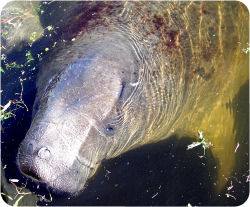![]()
GIS DECISION MODEL
Manatee Patterns
Facts about Manatee physiology, behavior, and habitat.
Description
 The West Indian Manatee is a large gray or brown aquatic mammal. Adults average about 10 feet long and weigh 1,000 pounds. They have no hindlimbs, and their forelimbs are modified as flippers. Manatee tails are flattened horizontally and rounded. Their body is covered with sparse hairs and their muzzles with stiff whiskers. Sexes are distinguished by the position of the genital openings and presence or absence of mammary glands. Manatees will consume any aquatic vegetation available to them and sometimes even shoreline vegetation. Although primarily herbivorous, they will occasionally feed on fish. Manatees may spend about 5 hours a day feeding, and may consume 4 to 9 percent of their body weight a day.
The West Indian Manatee is a large gray or brown aquatic mammal. Adults average about 10 feet long and weigh 1,000 pounds. They have no hindlimbs, and their forelimbs are modified as flippers. Manatee tails are flattened horizontally and rounded. Their body is covered with sparse hairs and their muzzles with stiff whiskers. Sexes are distinguished by the position of the genital openings and presence or absence of mammary glands. Manatees will consume any aquatic vegetation available to them and sometimes even shoreline vegetation. Although primarily herbivorous, they will occasionally feed on fish. Manatees may spend about 5 hours a day feeding, and may consume 4 to 9 percent of their body weight a day.
Reproduction and Development
Observations of mating herds indicate that females mate with a number of males during their 2- to 4-week estrus period, and then they go through a pregnancy estimated to last 12 to 14 months (O'Shea 1992). Births occur during all months of the year with a slight drop during winter months. Manatee cows usually bear a single calf, but 1.5 percent of births are twins. Calves reach sexual maturity at 3 to 6 years of age. Mature females may give birth every 2 to 5 years. The only long-term, stable bond between manatees is that between a cow and her calf. Weaning generally occurs between 9 and 24 months of age, although a cow and calf may continue to associate with each other for several more years. There is little information on the life-time reproductive output of females, although they may live over 50 years.
Range and Population Level
During the winter months, the United States' manatee population confines itself to the coastal waters of the southern half of peninsular Florida and to springs and warm water outfalls as far north as southeast Georgia. Manatees also winter in the St. Johns River near Blue Spring State Park. During summer months, they may migrate as far north as coastal Virginia on the east coast and the Louisiana coast on the Gulf of Mexico.
Manatee populations also exist outside the continental United States in coastal areas of the Caribbean and Central and South America. In Puerto Rico, manatees apparently occur around the southern and eastern end of the island and around nearby Vieques Island. Except for rare sightings, manatees seem to be absent from the Virgin Islands at present, but fossils have been found in middens on St. Croix.
The population of manatees in Florida has been estimated to be at least 1,865 individuals. There are an estimated 60 to 100 manatees in Puerto Rico. In the last decade, yearly mortality in Florida has averaged nearly 150 animals a year, double that of the preceding decade. The average proportion of first-year calves in the population is 10 percent with a range of 5 to 15 percent.
More Information: http://www.fws.gov/endangered/i/a/saa0c.html
Sightings
<Information>
Watercraft-related Deaths
<Information>
Carcass Locations
<Information>


